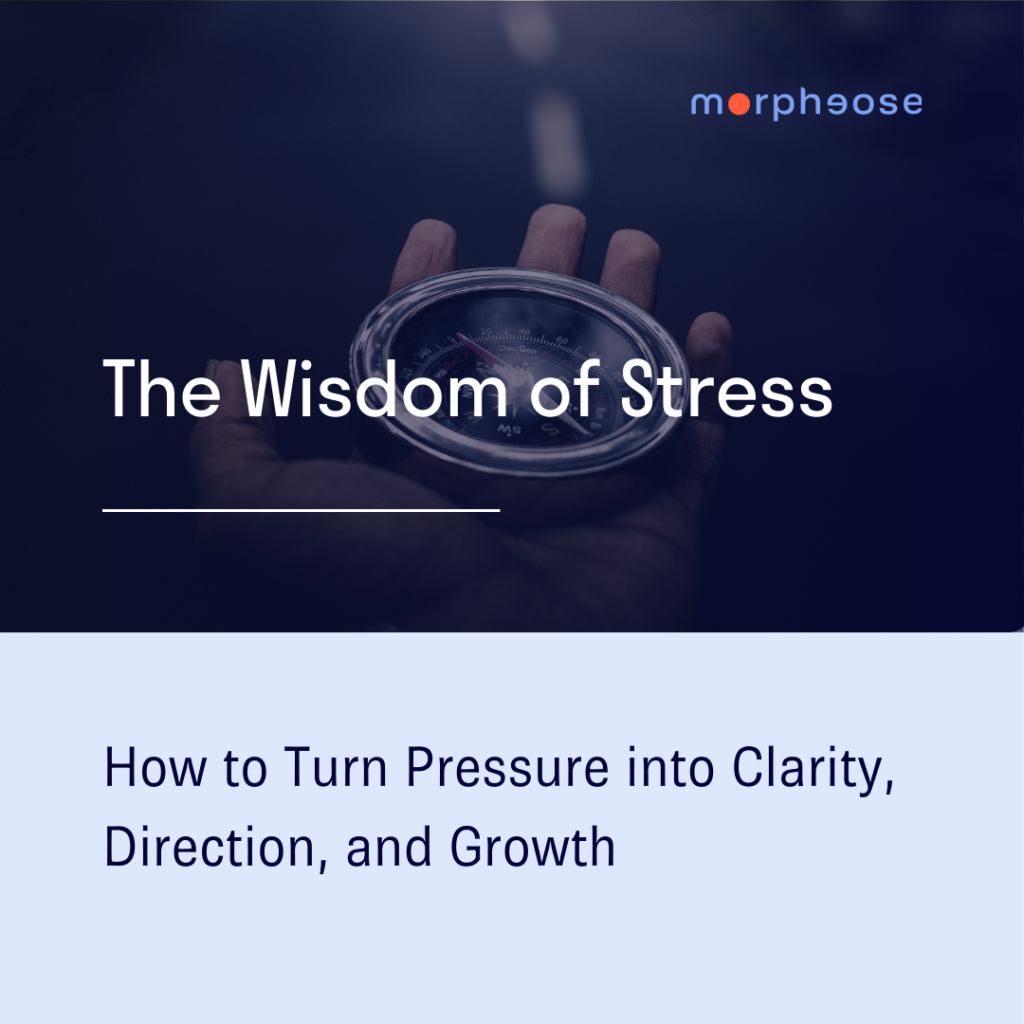
In a previous article, The Neurophysiology of Stress, we explored what happens in the brain and body under prolonged stress—and why regulating your nervous system is essential for mental clarity and performance.
But there’s more to the story.
Stress doesn’t only need to be managed. It can also be understood.
Because when we stop viewing stress as a malfunction—and start treating it as a signal—we unlock a deeper intelligence.
What if stress isn’t your enemy… but your teacher?
From Threat to Insight: A New Relationship to Stress
Stress is often seen as a barrier to performance. But what if it’s actually a signal—an intelligent feedback system designed to protect, inform, and adapt?
According to the Transactional Model of Stress and Coping (Lazarus & Folkman, 1984), stress arises when we perceive a mismatch between external demands and our internal resources [1]. In other words, it’s less about what’s happening and more about how we interpret our capacity to handle it.
In this light, stress becomes a real-time alert system, pointing to moments when something needs our attention:
- A value is being compromised
- A boundary has been crossed
- A role, identity, or strategy needs to evolve
Stress isn’t the problem. It’s a signal of potential misalignment—and an invitation to recalibrate.
What Stress Really Signals in the Workplace
Stress can take many forms in a professional context. Here’s what it might be telling you:
| Type of Stress | What It Indicates | Example |
|---|---|---|
| Cognitive Overload | You’re juggling too many inputs or lack focused time. | Too many back-to-back meetings with no space to think or process. |
| Value Misalignment | You’re engaging in tasks disconnected from your core motivations. | Delivering outcomes that feel ethically or creatively hollow. |
| Lack of Autonomy or Control | You’re operating in high uncertainty with little influence over outcomes. | Constantly shifting priorities without clarity or input. |
| Threat to Social Safety | Your belonging, credibility, or image feels at risk. | Feeling excluded, micromanaged, or underappreciated. |
| Role Ambiguity or Identity Shift | You’re unsure of what’s expected—or outgrowing your current identity. | Promotion without support, or feeling stagnant in a routine role. |
These aren’t signs of weakness. They are data points. Stress is showing you where your current strategies may no longer serve your goals, values, or growth.
Why Stress Feels So Overwhelming
When your brain perceives a threat—physical, social, or psychological—it activates the HPA axis, flooding the system with cortisol and mobilizing energy for short-term survival [2].
While helpful in bursts, chronic activation leads to:
- Impaired cognitive performance (working memory and decision-making) [3]
- Heightened emotional reactivity (amygdala overstimulation) [4]
- Reduced adaptability (rigid thought patterns and lower problem-solving) [5]
This is why we feel overwhelmed, stuck, or impulsive—not because we’re weak, but because we’re neurologically overloaded.
The Hidden Driver: Constant Stimulation & Digital Overload
In modern work environments, stress is no longer tied only to deadlines or high-stakes meetings. It’s embedded in the background noise of our hyperconnected lives.
The human nervous system evolved to deal with short-term, resolvable threats. But today, it’s being constantly activated by:
- A flood of notifications and messages
- Rapid, unrelenting task-switching
- The pressure to be responsive across multiple time zones and platforms
This chronic low-grade stimulation keeps the sympathetic nervous system engaged, preventing the body from returning to baseline. It contributes to fatigue, reduced focus, and a diminished ability to regulate emotion and attention.
Researchers call this attention residue—the mental drag that occurs when we jump from task to task without fully disengaging [6].
In our work at morpheose, we’ve seen again and again that learning how to pause—even briefly—is one of the most powerful practices for nervous system repair and cognitive clarity.
The Morpheose Approach: Turning Stress into a Compass
Once the nervous system is regulated, the real opportunity begins:
→ Learning how to listen to stress and decode what it’s trying to show you.
At morpheose, we teach a three-part introspective framework to do just that:
1. Notice – Track the Somatic Signal
Stress begins in the body before it becomes a thought.
Ask yourself:
- Where is this stress located?
- Is it a tension, pressure, tightness, or buzzing?
- What’s its temperature, texture, or shape?
Noticing is the first step toward building somatic literacy—a key factor in emotional intelligence and self-regulation.
2. Name – Identify the Context
Go beyond the sensation. What might this stress be related to?
Ask:
- What’s at stake here?
- What value or goal feels threatened?
- Is this stress pointing to growth, conflict, or an unmet need?
You’re not trying to get rid of the stress—you’re trying to understand it. This approach, used in narrative and somatic coaching, helps externalize the experience and reduce reactivity [7].
3. Navigate – Take Informed, Conscious Action
Once you’ve understood the signal, it’s time to respond rather than react.
That might mean:
- Setting a boundary
- Seeking clarity on expectations
- Delegating a task
- Reframing how you’re measuring success
- Or simply pausing to breathe and reset
Research shows that even brief practices like deep breathing [8] or mindful introspection [9] significantly enhance presilience, focus, and recovery.
Why This Matters in Business
Stress isn’t just a personal issue—it’s an organizational one.
- Leaders who understand their own stress can lead with emotional clarity
- Teams that normalize stress conversations build psychological safety [10]
- Cultures that support nervous system regulation see improved focus, collaboration, and innovation
In short: stress-presilient people build change-presilient organizations.
The Real Goal Isn’t a Stress-Free Life—It’s a Conscious One
Stress is inevitable—but suffering is not.
At morpheose, we help professionals, leaders, and teams work with stress, not against it—using introspective tools, altered states, and somatic techniques to turn pressure into purpose.
Next time you feel stressed, pause.
Feel the signal.
Ask the question.
Follow the message.
Because your stress might not be the problem—it might be the portal.
Ready to Transform Stress into Clarity?
If you’re ready to stop resisting stress and start decoding its wisdom, we can help.
At morpheose, we offer:
- 1:1 coaching for professionals in high-stakes or high-pressure environments
- Team workshops to develop emotional presilience, clarity, and communication
- Immersive programs combining introspection, breathwork, and altered states
Let us help you create space for reflection, regulation, and growth.
Cosima Coppola-Willi
Sources:
- Lazarus, R. S., & Folkman, S. (1984). Stress, Appraisal, and Coping. Springer.
- McEwen, B. S. (2017). Neurobiological and systemic effects of chronic stress. Neuron, 95(2), 279–293.
- Arnsten, A. F. (2009). Stress signaling pathways that impair prefrontal cortex structure and function. Nature Reviews Neuroscience, 10(6), 410–422.
- Ressler, K. J. (2010). Amygdala activity, fear, and anxiety: modulation by stress. Biological Psychiatry, 67(12), 1117–1119.
- Goldfarb, E. V., et al. (2017). Stress and cognitive flexibility. Journal of Cognitive Neuroscience, 29(1), 14–24.
- Leroy, S. (2009). Why is it so hard to do my work? The challenge of attention residue when switching between work tasks. Organizational Behavior and Human Decision Processes, 109(2), 168–181.
- Ogden, P., & Fisher, J. (2015). Sensorimotor Psychotherapy: Interventions for Trauma and Attachment. Norton.
- Hopper, S. I., Murray, S. L., Ferrara, L. R., & Singleton, J. K. (2019). Effectiveness of diaphragmatic breathing for reducing physiological and psychological stress in adults: a quantitative systematic review. JBI database of systematic reviews and implementation reports, 17(9), 1855–1876.
- Joyce S, Shand F, Bryant R, Lal T, Harvey SB (2018). Mindfulness-Based Resilience Training in the Workplace: Pilot Study of the Internet-Based Resilience@Work (RAW) Mindfulness Program. Journal of Medical Internet Research, 20(9):e10326
- Edmondson, A. C. (1999). Psychological safety and learning behavior in work teams. Administrative Science Quarterly, 44(2), 350–383.


